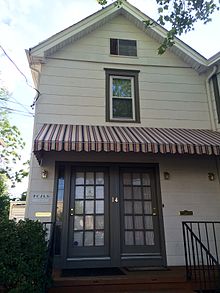Hoshū jugyō kō
Hoshū jugyō kō (補習授業校), or hoshūkō (補習校),[1] are supplementary Japanese schools located in foreign countries for students living abroad with their families.[2] The Ministry of Education, Science, Sports and Culture (Monbusho), as of 1985, encouraged the opening of hoshū jugyō kō in developed countries.[3] By May 1986, Japan operated 112 supplementary schools worldwide, having a total of 1,144 teachers, most of them Japanese nationals, and 15,086 students.The remainder of the curriculum consists of other academic subjects,[6] including mathematics, social studies, and sciences.Rachel Endo of Hamline University,[16] the author of "Realities, Rewards, and Risks of Heritage-Language Education: Perspectives from Japanese Immigrant Parents in a Midwestern Community", wrote that these schools "have rigorous academic expectations and structured content".[19] In the years prior to 2012, there was an increase in the number of students who were permanent residents of the United States and did not plan to go back to Japan.

JapaneseChineseWuhou DistrictChengduMinistry of Education, Science, Sports and Culturedeveloped countriesnihonjin gakkōdeveloping countriesJapanese educational systemMinistry of Education, Culture, Sports, Science and TechnologyConstitution of JapanJapanese languagePrinceton Community Japanese Language SchoolPrinceton, New JerseyhagwonChinese schoolskikokushijoJapanese AmericansU.S. citizensEnglish, their second languageHamline UniversityWashington, DC metropolitan areaCanterburyCardiffEdinburghLivingstonManchesterSunderlandOxcloseTelfordMorleyErewashJapanese Saturday School in LondonWarringtonYorkshireHumbersideStirchleyNorth East of EnglandTyne and WearNewcastle-upon-TyneList of hoshū jugyō kōBrookdale Community CollegeLehigh UniversityMultilingual MattersGeorgetown UniversityForeign Language AnnalsAmerican Council on the Teaching of Foreign LanguagesUniversity of MichiganRoutledgeMinistry of Foreign AffairsMcGill UniversityOchanomizu UniversityBilingual Research JournalWayback MachineLymm High SchoolUniversity of California, IrvineCarnegie Mellon UniversityOsaka UniversityUniversity of BonnSaitama Gakuen UniversityUniversity of TokyoTokyo Gakugei UniversityBrusselsGenevaLondonChicago areaGreater CincinnatiColumbus, OhioDallasDetroitHoustonIndianapolisLos Angeles areaMiami areaJWS of New YorkPortland, OregonSan Diego (Minato)San Francisco JSSeattle areaTorontoQueenslandDüsseldorfMadridZurichHartfordMinneapolis JSMinnesota JSMontrealNishiyamato AcademyOrlandoSt. LouisAustralia (Canberra, Melbourne, Queensland)Lycée International de Saint-Germain-en-LayeCité Scolaire Internationale de LyonSundai Michigan International AcademyJapanese Ministry of EducationJapanese diasporaRyukyuan diasporaSouth AfricaCaribbeanDominican RepublicJamaicaCanadaBritish ColumbiaUnited Statescities with large Japanese-American populationsArgentinaBoliviaBrazilSão Paulo CityColombiaMexicoMexico CityParaguayUruguayVenezuelaMainland ChinaShanghaiJapanese orphansHong KongIndonesiaNorth KoreaSouth KoreaMalaysiaPhilippinesSingapore